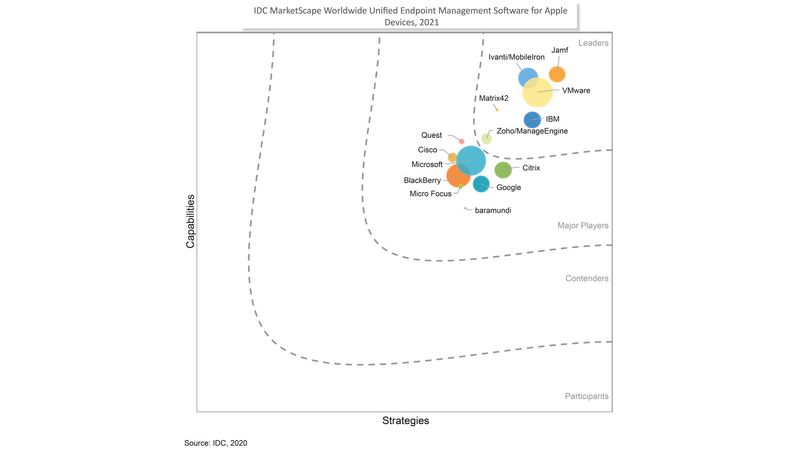The proliferation of Apple devices in business is causing many organizations to rethink their approach to overall endpoint provisioning, management and security.
As such, Jamf was positioned in the Leaders Category in the IDC MarketScape: Worldwide Unified Endpoint Management (UEM) Software for Apple Devices (doc # US46965620, January 2021) report.
According to the IDC MarketScape, Jamf’s singular focus on Apple products allows us to release features that support all new Mac, iPhone, iPad and Apple TV devices on the day they're available. Jamf is able to achieve this for two reasons:
- Focusing all R&D and engineering resources on rapid macOS, iOS, iPadOS and tvOS feature support.
- Being architected for Apple to be close to same-day ready before the work even starts. Example: We don’t employ kernel extensions. Our security solution innovatively uses available APIs to accomplish what most security solutions run in the OS kernel.
Commonly referred to as same-day support, Jamf has and will continue to focus on empowering users, IT and organizations to instantly take advantage of the security, productivity and continuity features Apple releases. But, at Jamf, we see this as the bare minimum. Complete Apple Enterprise Management is becoming essential to maximize Apple initiatives and ultimately best connect, manage and protect corporate Apple devices throughout their lifecycle.
First IDC MarketScape to recognize UEM for Apple
IDC is the first analyst firm (and likely not the last) to identify the UEM for Apple Devices category, evaluate players in the category and make recommendations for Apple ecosystem management. IDC has chosen to no longer ignore the dedicated Apple approach and rightfully so.
Mac usage in the enterprise is growing by many measures. In the United States, average penetration of macOS devices is around 23%, compared with 17% in 2019, according to IDC's 2020 and 2019 Enterprise Mobility and Workspace Software Surveys (doc # US45173520, June 2020). Not only is this the highest Mac market penetration ever, but it says that Mac grew 6% in one year. Mac growth within the commercial enterprise is accelerating, and the revolutionary Apple M1 Chip for Mac which delivers faster and more efficient performance will only serve as a catalyst for this trend to continue.
But Mac is not the only Apple product the enterprise is increasingly relying on. iPhones account for 49% of the smartphone installed base among U.S. enterprises, and iPads make up the majority of tablets used in business.
Apple is rapidly growing in the enterprise, and the expectation for employees to have the ability to use Apple at work is more critical than ever in order to hire/retain top talent and keep users productive and their privacy protected while levering technology.
Jamf firmly believes that users deserve the right to choose the technology that makes them their most productive selves. And when they choose Apple, we know that having a dedicated Apple solution is the way to maximize the device and ultimately deliver the best experience to the user. Plus, happy and productive employees stick around, do their best work and don’t bog IT down with help tickets.
Apple is expanding its enterprise footprint and so the need for dedicated solutions that enhance the unique capabilities that only Apple can provide is here to stay. Just ask IDC.
IDC MarketScape vendor analysis model is designed to provide an overview of the competitive fitness of ICT suppliers in a given market. The research methodology utilizes a rigorous scoring methodology based on both qualitative and quantitative criteria that results in a single graphical illustration of each vendor’s position within a given market. The Capabilities score measures vendor product, go-to-market and business execution in the short-term. The Strategy score measures alignment of vendor strategies with customer requirements in a 3-5-year timeframe. Vendor market share is represented by the size of the circles. Vendor year-over-year growth rate relative to the given market is indicated by a plus, neutral or minus next to the vendor name.
by Category:
Have market trends, Apple updates and Jamf news delivered directly to your inbox.
To learn more about how we collect, use, disclose, transfer, and store your information, please visit our Privacy Policy.

